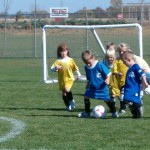 The word ”play” gets batted around a lot in conversations about children’s learning and development needs, but sometimes different people are holding different notions of what the word ”play” actually means. In this two-part blog post, I want to help clarify what I believe true child’s play actually is. In this first post, I want to help define the word by saying what it is not (and what some people think it really is). So okay, here goes:
The word ”play” gets batted around a lot in conversations about children’s learning and development needs, but sometimes different people are holding different notions of what the word ”play” actually means. In this two-part blog post, I want to help clarify what I believe true child’s play actually is. In this first post, I want to help define the word by saying what it is not (and what some people think it really is). So okay, here goes:
1. Play is NOT competitive sports: Activities like organized soccer, baseball, basketball, or football are not children’s play because they involve adult-imposed rules and schedules that children generally must follow or suffer the slings and arrows of parents and peers’ disfavor.
2. Play is NOT digital anything. Yes, I know there are apps and sites and software programs that look like play (for example, with Minecraft, kids can play with blocks etc.). The problem, again, is that digital everything is programmed by adult minds, not by children’s minds, and the structures that children must work with are adult-imposed. Moreover, there’s a real problem with anything that’s digital as far as children’s play is concerned. Digital, after all, means that everything is programmed as 0’s and 1’s. Children’s minds don’t work (or play) like that. In true play, children imagine all the subtleties and nuances that scurry around in the nooks and crannies and spaces and corners that 0’s and 1’s never reach.
3. Play is NOT commercially made games. Yes, families can have a lot of fun playing games like Monopoly, Scrabble, and Pictionary, but again, they’re adult-imposed rules. Children’s play must come from children creating their own rules (and if you see kids making up their own rules while playing Pictionary or another commercially-manufactured game, then yes, okay, that’s moving closer to what play really is all about), but still the structure of the game (pieces, board, board design etc.) limit the possibilities of what children can do (and possibilities are a huge part of true child’s play).
4. Play is NOT ”play with a purpose”. This is a form of so-called play that has become very popular with the advent of ”academic scrunch-down” (my admittedly poor working term for how we’re expecting young children to do academic work that was only deemed appropriate for older kids a few years ago; I’m talking about preschool kids and kindergarten children doing worksheets and taking tests, and that sort of thing). In this hideous form of pedagogical child abuse, children are allowed to play ”if there is a purpose”, that is, if it teaches specific objectives that will directly or indirectly lead to academic related skills. So, yes, in this sort of restricted view, we’ll let kids stand around the tub of water to play ”Sink or Float” where they must try to determine if different types of items (sponges, rocks, paper etc.) will sink or float, and we’ll let them do this activity because it teaches skills like ”volume” or ”inference” or ”hypothesis testing” or at least prepares the way for these skills to be learned later on. No, this is not right. Children play because it is an activity worth pursuing in its own right, even if it leads to absolutely no outcomes, objectives, or skills. I’ll talk about why this is the case in my next post.
For more information about the importance of play in the development of the child, and the need to incorporate it into school life, see my book If Einstein Ran the Schools: Revitalizing U.S. Education
This post brought to you by Thomas Armstrong, Ph.D. and www.institute4learning.com
Follow me on Twitter: @Dr_Armstrong



















